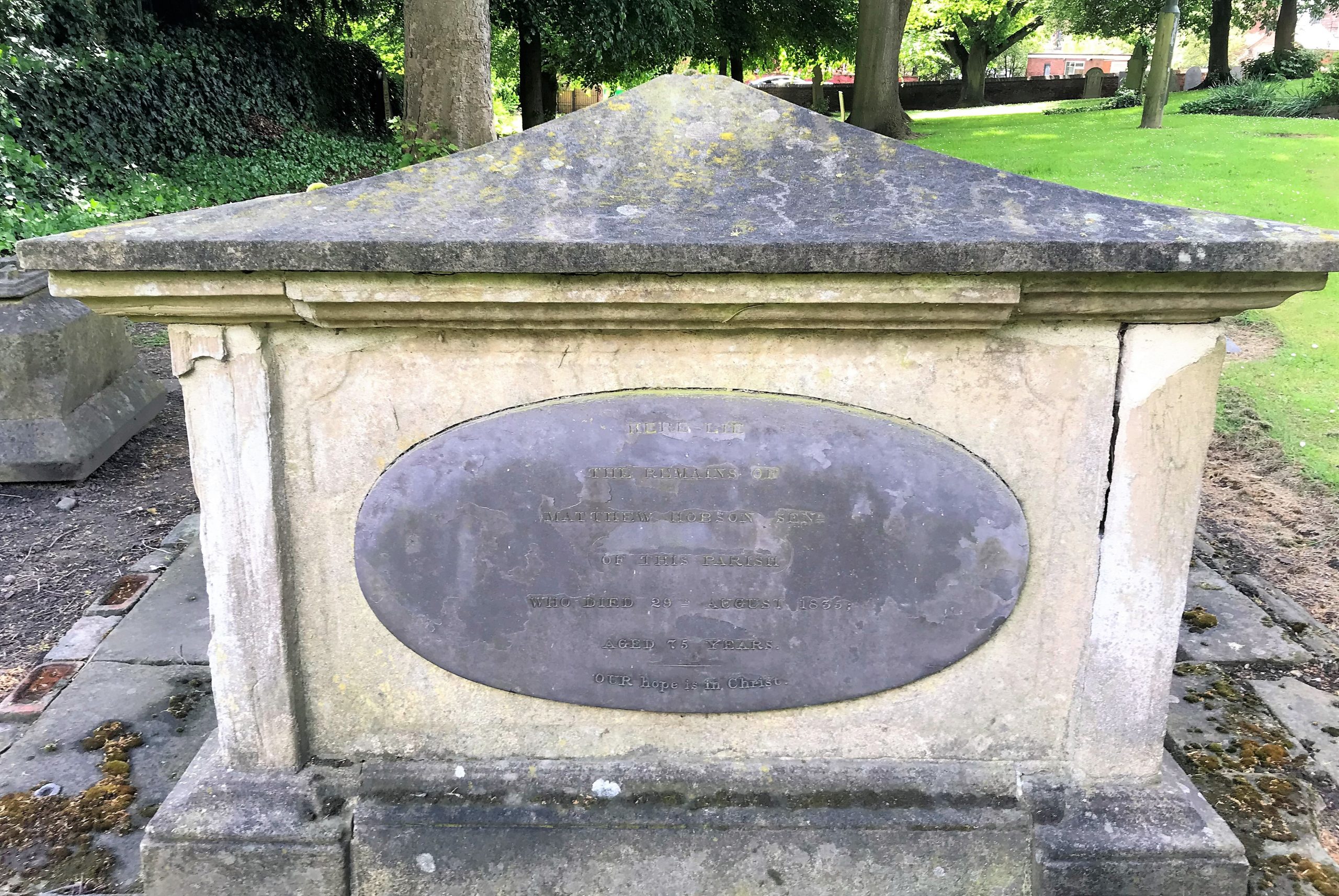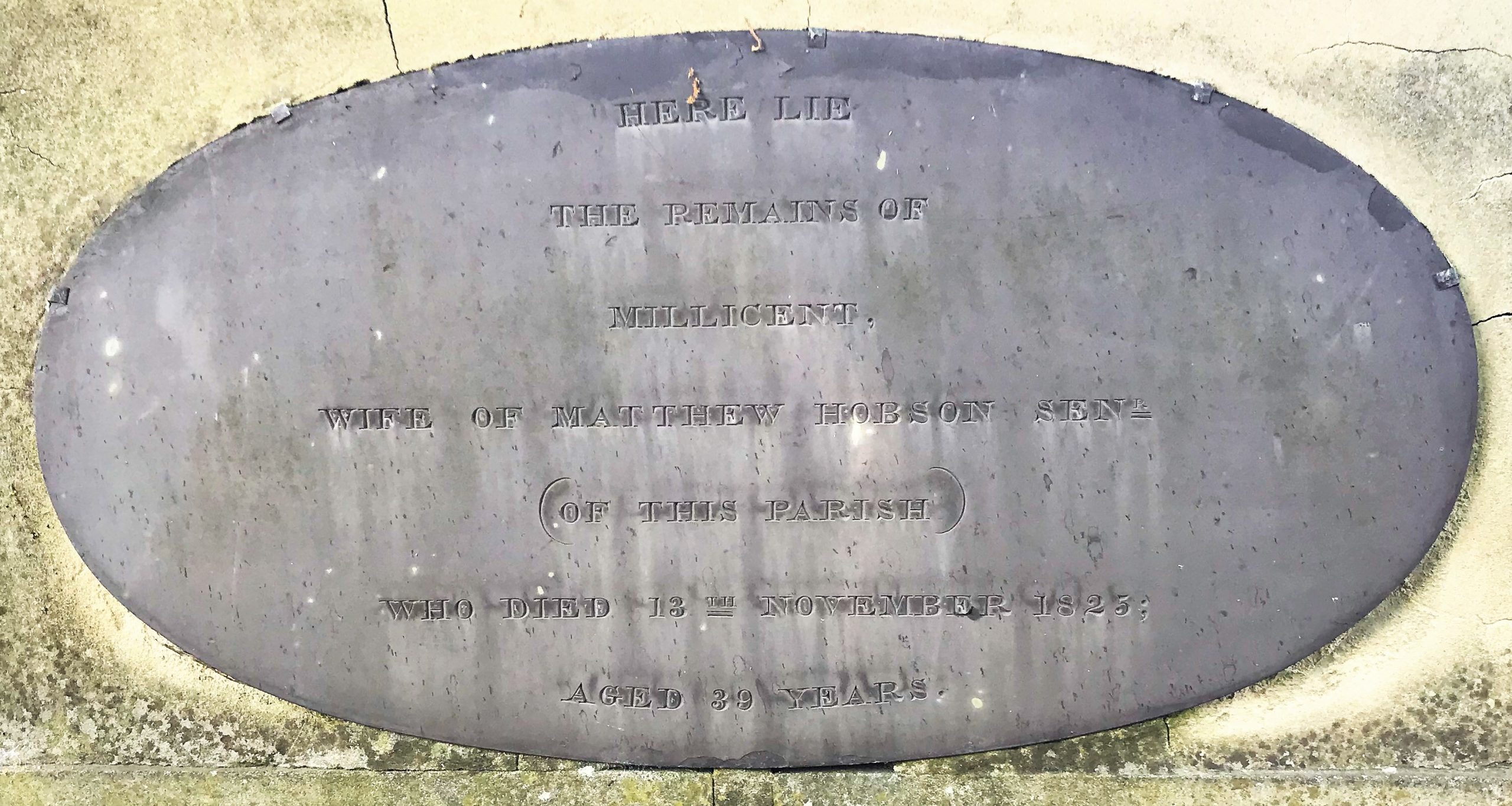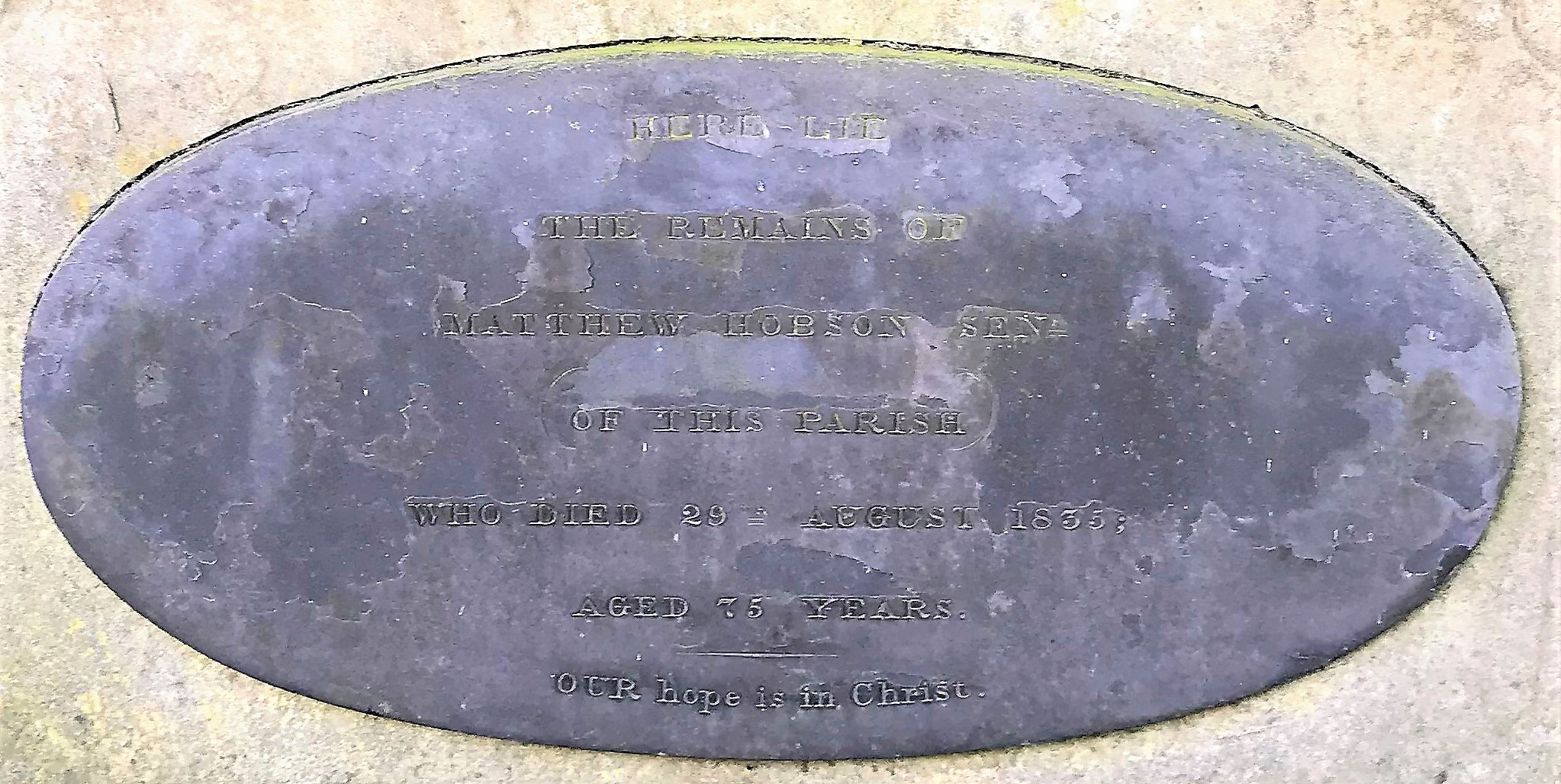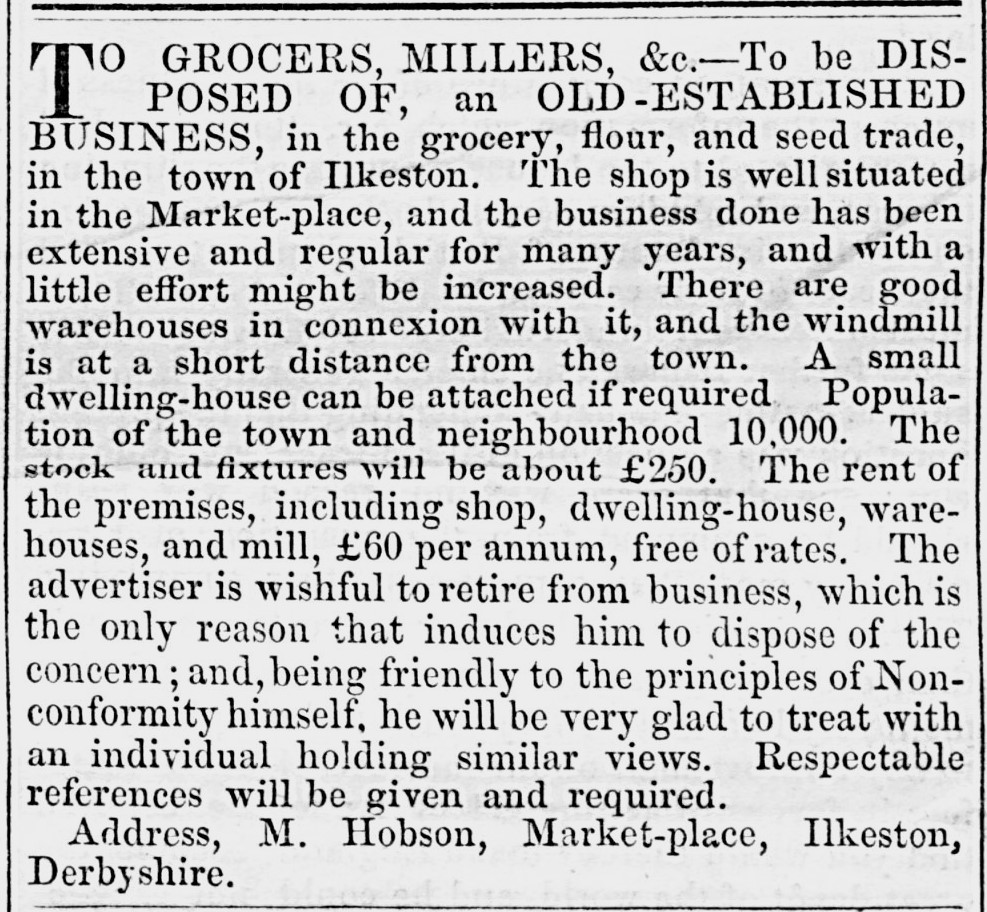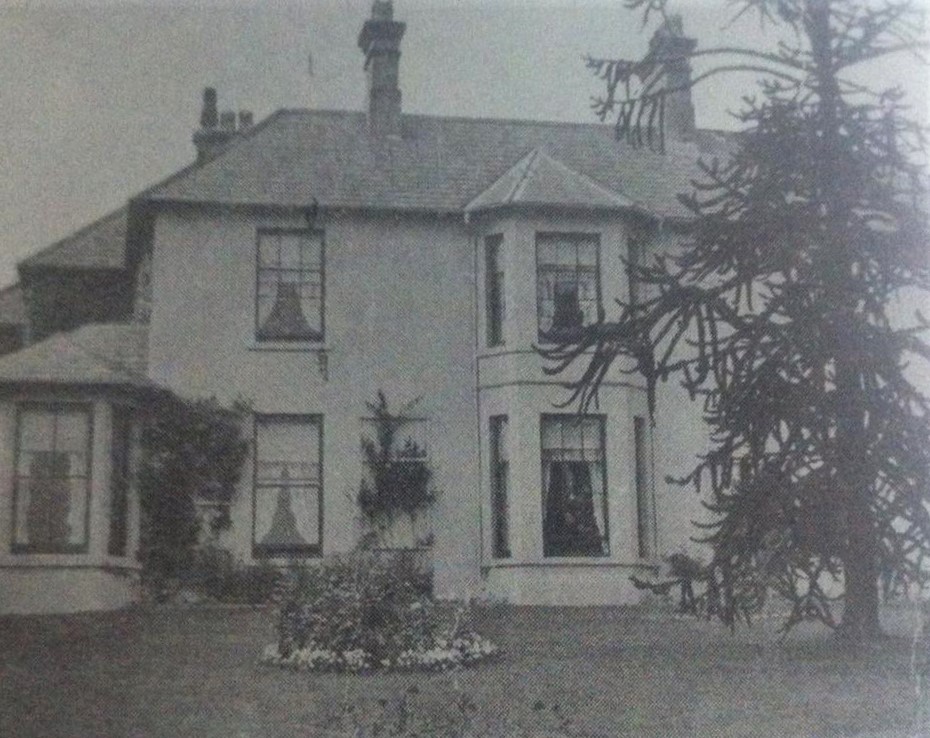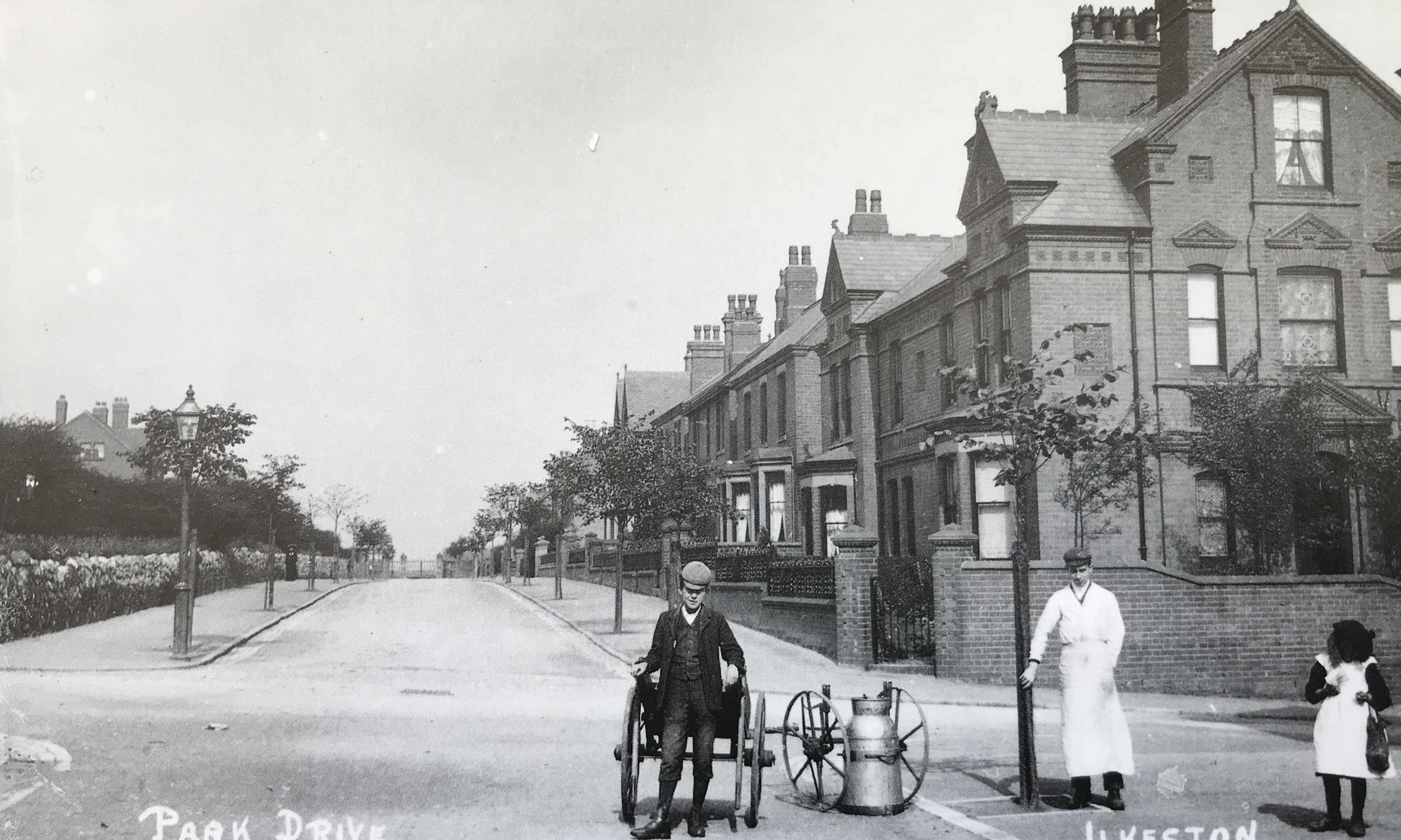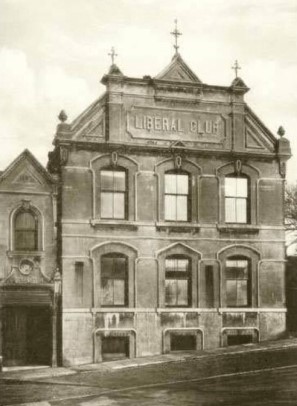We now walk on, a very short distance, from the doctors’ house, in the direction of Anchor Row and St. Mary’s church, but before we arrive at either of them we are at the property of the Hobson family. As Adeline points out, this was “Matthew Hobson’s corn, seed and grocery shop”; she seems to be writing about Matthew Hobson junior.
This was later to be the site of the old Liberal Club on the east side of Lower Market Place but at this time was the house and shop of Matthew Hobson senior. He owned land in Boot Lane — later Stanton Road — and had acquired his Market Place premises in 1825 …. premises with yards, barns, stables and other outbuildings attached. Before that, from about 1789 (when the property was mortgaged to Francis Elliott) the property had served as the old Anchor Ale House, but remained as an inn only until Matthew senior acquired it. Late in the eighteenth century it was owned by Thomas Bradley the clockmaker … this started a long line of Bradley beer-house keepers up Heanor Road which even later moved into the Rutland Arms in Heanor Road. As well as this dwelling, Matthew senior gained a row of eight tenements built by John Shaw, timber merchant of Trowell, standing in Anchor Row.
The sketch below is taken from William Gauntley’s map of 1795. X marks the site of the old Anchor ale house, later the site of Matthew Hobson’s premises … and later still, the site of the Liberal Club.
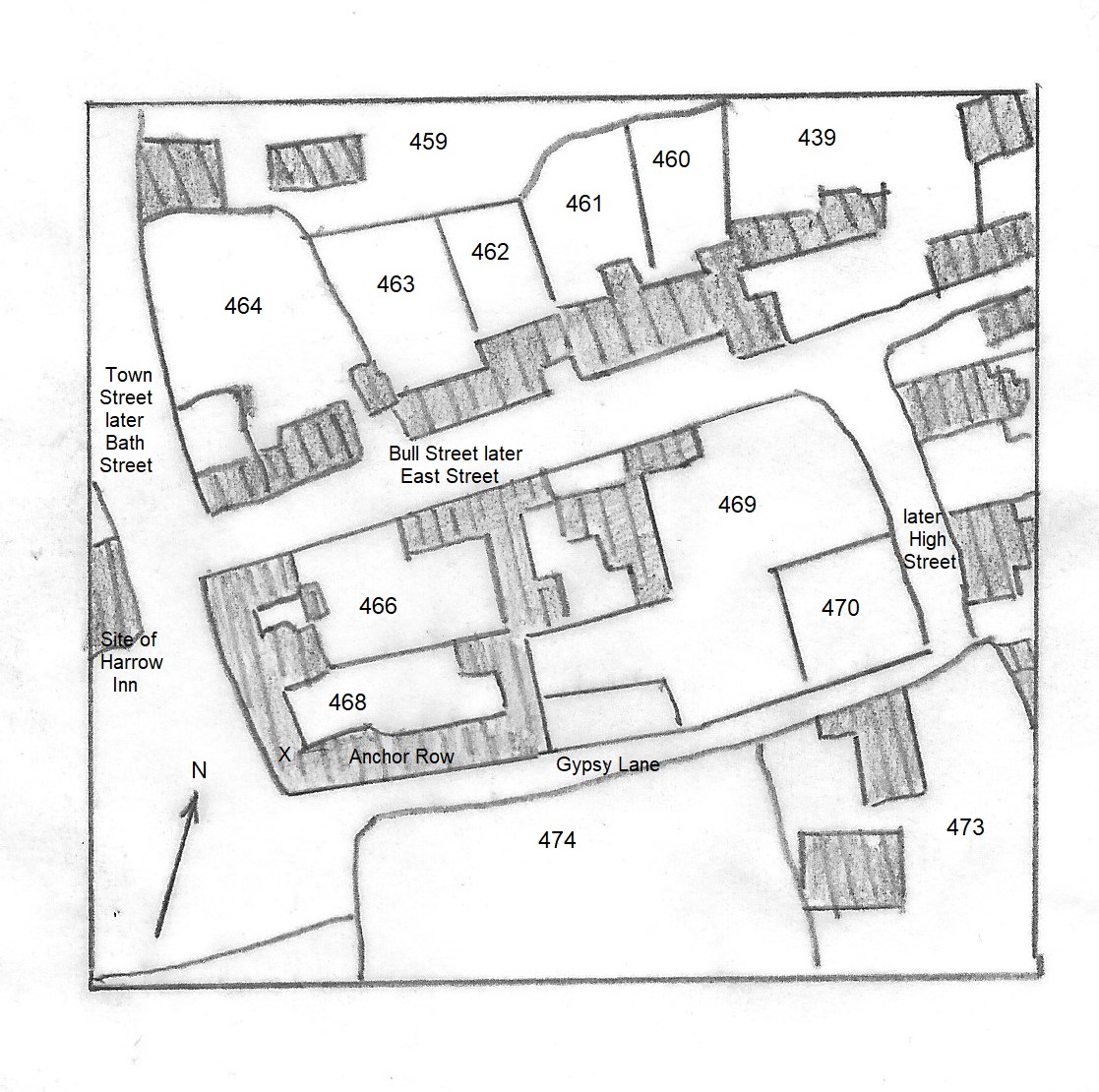
———————————————————————————————————————————————————
Matthew (1760-1835) and Millicent Hobson (1786-1825)
On June 7th, 1809 Matthew senior married Millicent Hodgkinson, the daughter of Littleover farmer Richard and Elizabeth (nee Wade). On October 24th of the following year their only son, Matthew junior, was born. Millicent died on November 13th, 1825, aged 39, and after the death of his father on August 29th, 1835, son Matthew took over the family interests and continued to live in the Market Place house, as miller and merchant, for about 20 more years.
There was also a daughter — Mary Ann — born to Matthew and Millicent on May 17th, 1823, but she died, aged 10 years 5 months, on November 1st, 1833 and was buried in St Mary’s Churchyard.
Matthew senior and Millicent are together in the family vault (above), close to the east end of St. Mary’s Church.
Here lie the remains of Millicent, wife of Matthew Hobson Senr (of this parish) who died 13th November 1825; aged 39 years.
Here lie the remains of Matthew Hobson Senr (of this parish) who died 29th August 1835; aged 75 years. Our hope is in Christ.
Their details, above, are found on opposite sides of the vault
Matthew junior (1810-1884), son of Matthew and Millicent.
In an uncomplementary article in the Nottingham Journal of 1844 Matthew was described thus: “a pompous, portly personification of prejudice and bigotry, possessing a fine rubicund countenance, quite unimpaired or unruffled by the lines and furrows of intellect, and whose face presents a striking title-page to a vast volume of ignorance“. This was inserted in the paper by a Conservative, aghast at the behaviour of Matthew, a Liberal, during a recent Court Baron session in Ilkeston.
Writing of an experience about 1845 is John Cartwright who lived in South Street at that time…
“It was (Matthew Hobson) who first caused me to tell the time by the clock. When a very little fellow I was sent to Hobson’s shop pretty frequently, and one day previous to handing me the required goods, he said, “What o’clock is it, Johnnie?” at the same time requesting me to look at the church clock. Not caring to acknowledge my ignorance, I guessed the time, and got over my difficulty. Feeling ashamed of myself, I resolved to go straight home and take lessons on ‘grandfather’s clock’ at once, and did not stay on the way back either to watch the cricket practice on the Rutland Ground, or even to play marbles with my old school fellow, Henry McDonald, a nephew of the Messrs. Carrier; neither did I resume play until I had mastered the art of telling the seconds and minutes and hours by the clock.”
By the summer of 1848 it seems that Matthew junior wished to retire from business and so put his Market Place trade up for sale, though this wouldn’t immediately necessitate the Hobson family leaving its central home. It was at this time that Paul Hodgkinson took over the Market Place trade.
from the Patriot (June 5th, 1848)
What does Adeline have to say ? … “Matthew (junior) and his wife lived here (in the Market Place) until he acquired the Field House property. (below)
It seems that Matthew junior contemplated building a new “Villa residence” as early as June 1850; by that time he had employed the services of Nottingham architect J.C. Gilbert, had drawn up plans and was seeking builders’ tenders. His Field House off Field Road was built about 1854 for Matthew and his family, near the site previously occupied by a windmill, which had been moved to Derby Road. The house was demolished in 1939.
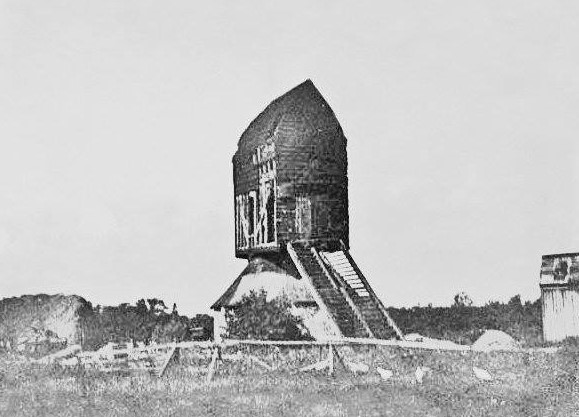 Above is said to be the Hobson Windmill — most probably not the one on the Field House site; there is no windmill shown there on the 1866 Local Board map. This is the ‘removed’ windmill as it stands in Derby Road and can be seen on the 1880 map of Ilkeston
Above is said to be the Hobson Windmill — most probably not the one on the Field House site; there is no windmill shown there on the 1866 Local Board map. This is the ‘removed’ windmill as it stands in Derby Road and can be seen on the 1880 map of Ilkeston
Matthew left his Market Place residence and went to live at Field House with his first wife, Hannah (nee Taylor) whom he had married on November 6th, 1832. She was the daughter of John Taylor, farmer of Little Hallam and his wife Hannah (nee Cocker).
Hannah Hobson died 30 years later – on June 13th 1862 at Field House.
Being an ardent Non-conformist – attending the Independent Chapel in Pimlico — Matthew had no wish to have his wife buried at the Parish Church, but what was the alternative? Despite the fact that Ilkeston now had a rapidly expanding population and the churchyard at St. Mary’s was filling up, the town had no cemetery to cater for those like Matthew who wished a non-denominational burial. Consequently he decided upon what the Ilkeston Leader described as ‘an extraordinary burial’ for his wife. Her body would be interred a few yards westwards of Field House, amongst a grove of trees. As well as the mourners who were protected from inclement weather by a spacious tent, her burial attracted several hundred spectators, all of whom were allowed to view the coffin as it lay in its brick-lined grave.
“The greatest decorum was maintained throughout, and many remarked as they retired, that a burial so extraordinary would long be remembered in Ilkeston”.
Four years later, Hannah Hobson’s remains were removed and re-interred at the newly-established Ilkeston General Cemetery on Stanton Road in ‘Hobson’s Closes’.
The map above is adapted from the Ilkeston Board Map of 1866. It shows the site of the Ilkeston General Cemetery Chapel in Stanton Road, soon to be officially used for the first time. Hobson’s Closes are to its left (west) and Matthew Hobson’s Field House is at the end of a lane which runs off from Havelock Street to the north.
“After Matthew’s wife’s death, he married the lady who had been his late wife’s companion.” writes Adeline.
By the time of his first wife’s reburial, Matthew had married his second wife, Jemima Grammer, oldest daughter of farmer Thomas of Greasley Castle, and Martha (nee Taylor).
Just before Christmas of 1877 Philip Paul of Pimlico, a domestic servant employed by Matthew, noticed that, where there should have been 38 fowls in Matthew’s fowl-house, there were now only 31. Blood, feathers and foot-marks were found near the entrance. Was someone making provision for the season’s festivities ?!
The police were brought in and somehow Inspector John Cowley was directed to the house of John Skinner. The latter was led back to the Hobson fowl-house where his boots exactly matched the imprints left at the scene of the crime.
At his subsequent trial John was jailed for nine months, with hard labour.
Matthew was a member of the Local Board from its formation until he resigned in 1876, and before the establishment of that Board he was for many years surveyor of highways.
Elected back onto the Local Board in April 1881 as a Ratepayers’ Association candidate, Matthew resigned in April of the following year when his wife Jemima became seriously ill. (Henry Clay senior of the Mundy Arms was ‘co-opted’ to take his place … a decision that was to have ramifications)
Though holding opposing political views, ‘Rambler’ conceded that “with an honest disregard of political ties, Mr. Hobson has endeavoured during his brief term of office, to conduct local affairs in a spirit worthy of the imitation of those who may occupy the same important and honourable position in the future”. (IP April 1882)
Matthew died at Field House on August 12th 1884, aged 74, two years after the death of his second wife, Jemima, when his health started to deteriorate.
His obituary in the Ilkeston Advertiser reminded Ilkestonians that Matthew was “a Liberal and Nonconformist of the staunchest character”, “an ardent advocate of the adoption of the Local Government Act”, “a founder of the ratepayers’ association, a promoter of the Ilkeston General Cemetery, an undenominationalist in educational matters” and “the chief promoter of the British School”, had a deep involvement in local charity work, and “like his father before him, he held to the Independent form of church faith and order”.
“Up to the last he took a deep interest in all matters pertaining to the welfare of the town, and his loss will be deeply regretted by a large number of our readers”.
The Pioneer added to the list.
Matthew’s ardent Liberalism inclined towards Radicalism and “his purse and influence constituted him the leader of the party for many years”. In later life these tendencies ‘cooled’ so that “in parochial affairs (he) repeatedly voted for the ‘best men’ irrespective of politics or religious proclivities”.
“It was on his motion that the Town Hall was erected, and he strongly interested himself in obtaining the holding of Petty Sessions and a County Court at Ilkeston. The Cottage Hospital scheme, and other charitable movements generally found in Mr’ Hobson a ready patron and supporter”.
The children of Matthew Hobson junior and Jemima (nee Grammer)
There were at least five children..
1 Jemima (August 21 st, 1865 -February 3rd, 1933) … she lived as a spinster in Ilkeston, all her life, the later part of which was spent in Park Avenue. She died at Number 18.
2 Henry (1867 – ?)
3 Millicent (1868 -1953) who married printer Thomas Edwin Roe in 1897 at the Independent Chapel.
4 Mary (April 27th 1870 – January 9th 1943) married lace manufacturer Charles Alan Sudbury (December 1st 1872- January 30th, 1914), son of Francis and Elizabeth (nee Bennett), on October 6th, 1896, at Ilkeston Independent Chapel. The couple lived in Park Avenue where Mary died, at Number 1.
Interestingly Mary’s father, Matthew, built Field House about 1854, though at the time of her marriage, she had moved out of those premises, which were then occupied by her future husband, his father and other family members.
In late July, 1892, then living at Field House, Charles had found himself locked into the premises of the Nottingham Machinists’ Co. Ltd., a cycle works at Kensington !! He had been taking photos of the machinery there, lost track of time and was inadvertently locked in. When he tried to climb out of an upstairs window he discovered that he wasn’t a very able ‘mountaineer’ — he fell a considerable distance down to the floor and was discovered unconscious there. Taken home, medical assistance was soon on hand but he still lay in ‘a very critical state’. Not critical enough to prevent recovery however — nor to prevent him, like his father, becoming Mayor of Ilkeston (1909-1910)
5 Frank (August 23rd,1874 – ?) married Sarah Flinders, daughter of needlemaker Samuel and Sarah (nee Spencer), in 1873, at Ilkeston Independent Chapel.
Looking at Park Avenue about 1905, number 1 is the first house on the right.
“Matthew Hobson also had the mill in Derby Road, his miller was the late Paul Hodgkinson”.
At the time of his death Matthew held much property and land (freehold and copyhold) in the district, including his Market Place grocer’s shop and the eight houses of Anchor Row, a house and shop and attached land in South Street (occupied by builder John Manners), several houses and land in Nottingham Road, two cottages in Pedley Street, over 16 acres of land by the Erewash Canal and 15 acres at Little Hallam.
On July 31st, 1899 parts of Matthew’s estate were offered for sale. These included a couple of lots of freehold building land with frontages to Hobson Street(sic) and Stanton Road; a copyhold field of grass known as Appleby Close (covering the north side of what is now Hobson Drive); a copyhold field of arable land in Little Hallam, farmed by Isaac Wilkinson junior and called Holly Bush field; a neighbouring copyhold field of pasture and a similar field of pasture in Little Hallam Lane, both kept by butcher William Twells; all were unsold. However a small freehold factory in Nottingham Road occupied by Walter Cordon was bought by Alderman Francis Sudbury (this was next door to the Congregational Mission House chapel in Nottingham Road); in the same lot were the two houses 311 and 312 Nottingham Road also bought by Francis. Houses in Gilbert Place (numbers 1 to 4 inclusive) and 313 Nottingham Road were sold to Isaac Simpson, while number 330 Nottingham Road with adjacent building land was bought by Ilkeston builder John Reeve — John also bought the final lot, another piece of building land in Nottingham Road.
————————————————————————————————————————————————————
Paul Hodgkinson (1823-1889)
Adeline remembers that …. “Paul Hodgkinson afterwards took over the shop in the Market Place and lived there. He also had the mill in Derby Road”.
Gap alert !!
I suspect a connection between Matthew Hobson senior’s wife Millicent who was born in Mickleover and Paul’s family, several of whom were born in Littleover and Mickleover though later living in Kniveton.
What that connection (if any) is, I have yet to establish.
Martyn Taylor commented …
In her letters cited in Old Ilkeston, Adeline Wells surmises that Paul Hodgkinson (1823-1889), who took over Matthew Hobson’s shop in the Market Place, may have been related to Matthew Hobson senior’s wife, Millicent Hodgkinson (1786-1825). He was indeed. Millicent’s brother John (1782-1856) was Paul’s father. I have researched the Hodgkinsons extensively, my mother being one of their descendants.
———————————————————————————————————————————–
Born in Kniveton, Derbyshire in 1828, a son of farmer John and Mary (nee Spencer), Paul Hodgkinson was initially an apprentice of Matthew Hobson, then his manager, and then principal of the grocery and millering businesses.
In September 1849 he married Sarah Fletcher, daughter of Mapperley farmer John and Eliza (nee Taylor, the daughter of John and Hannah (nee Cocker)).
‘Mr Hodgkinson was a very precise and methodical man, whose steady measured walk was quite in keeping with his unobtrusive nature’. (Sheddie Kyme)
Reminiscing once more, John Cartwright ….
“Sometime (about 1845) I took to studying Mr. Paul’s profile with a view to a pencil sketch, which sketch was made from my mental notes on reaching home. This ‘likeness’ was completed in due time, and laid before the original, who was so pleased with the attempt that he made the young artist a present of a shilling, which was then a very big sum to me; but it was not the present that was everything. I felt proud to think that my work was appreciated. At that time Mr. Hobson lived on the premises, and he and Mr. Joseph Bailey, lace manufacturer, were staunch friends. Just as Mr. Paul had given me the piece of silver, Mr. Bailey passed through the shop, and was shown the sketch, when he exclaimed, “Why, Paul, that’s you, and a capital likeness, too”. My old schoolmaster, Mr. Milner, afterwards complimented me on my work, and suggested my drawing a similar one in crayon; but the second, although commenced,, has not yet been completed, although at this moment, I am in possession of the very box of crayons, holders, wash leather, &c., complete that were used by me at that time, and the year 1845 is marked on the box”.
In the summer of 1880, into Paul’s Market Place shop walked William Henry Edmunds with some good news. He was the son of ‘Mrs Edmunds’ whose large wild beast show was soon to come to town, and he was an ‘outrider’ with the task of publicising the forthcoming visit. He had a pony and cart, containing posters of the show, and needed corn and feed not only for this animal but for several of the show’s horses soon to arrive.
Pound signs may have flashed before Paul’s eyes as he visualised the prospect of this bumper future order, but then William Henry calmly slipped into the conversation that he was in immediate need of four shillings — could Paul lend it to him? The shopkeeper smelled ‘a rat’ but his customer assured him that a ground in town had already been reserved for the show, and Paul was persuaded to hand over three shillings.
Just as William Henry pocketed the cash and left his shop, nagging doubts remained in Paul’s mind and he contacted the police.
His ‘customer’ was arrested, detained in the lock-up, and subsequently charged with obtaining money by false and fraudulent pretences.
The wild beast show was not on its way to Ilkeston and William Henry Edmunds had no connection with it.
Paul was a Congregationalist in religion and a Conservative in politics.
For many years he and his family lived in this Market Place site until he moved into his new residence of Kniveton House, Derby Road, in early 1885. Then he advertised his premises to let. They were described as ‘good commodious shop premises and house where a good trade has been carried on for many years as Grocer, Provision Merchant, Seed and Linseed Cake Dealer … with or without Wind Corn Mill and requisite Buildings’.
By November of 1885 Paul had decided to retire from farming and was then selling off his animals — 13 superior cows and 1 well-bred bull — as well as three stacks of hay, plus all his wagons, carts, machines and implements.
Paul died at Kniveton House on February 25th 1889. His wife Sarah died on June 9th 1898 at the same address.
Eventually the Hodgkinson business premises were sold to a League of Gentlemen with Liberal intentions looking for a club house. (see below)
“There were two children, John and Sarah.
Sarah married Mr. Thompson. She died when her first baby was born. John died a year or so later.”
Their daughter Sarah married mechanical engineer John Ralph Melland Thompson, son of Richard Melland Thompson and Elizabeth (nee Hodgkinson) in September 1875 and she died at the family’s Market Place home in August 1878, aged 23.
Their only other child was John Fletcher Hodgkinson who continued to live with, and work with, his father until he died in October 1882, aged 30.
Both children were buried in the grand family vault in the General Cemetery, later joined by their parents.
Paul’s brother John was the oldest child in the family. In 1838 he married Mary Hurd, daughter of Kniveton farmer John and Hannah (nee Blore), and both of them were National School teachers.
In later life they moved into Ilkeston where John farmed in Nottingham Road. He too died at Kniveton House in May 1893.
————————————————————————————————————————————————-
The Liberal Association and Liberal Club
On June 24th 1881 a meeting of the combined ‘forces’ of Ilkeston’s Nonconformists and Liberals met at the South Street schoolrooms with Herbert Tatham in the chair. This was the first time that the formation of a Liberal Association in the town was suggested, a suggestion encouraged by the recent results of the School Board elections.
On the site of Paul Hodgkinson’s premises a Liberal Club was ‘developed’. The original idea came from William Tatham, lace and needle manufacturer of Stanley House, in 1886. A limited liability company was then formed, to raise finance for the scheme, and George Haslam was appointed as architect, his brief being to draw up plans for the alteration of the tumble-down property on the site to the requirement of the Liberal Club.
Many years before, the Anchor Inn* had stood on this site, but this had been followed by the shop and several dwelling houses belonging to Matthew Hobson and then to Paul Hodgkinson. These premises were purchased from the latter in 1886 for £2200 and it was these premise that were the basis for the new design.
Built in 1887-8 by George Good, it was designed to accommodate all the Ilkeston party members … 300 in total. “The exterior of the club is of a neat and imposing character, and it is quite an ornament to the Market-place.The interior consists of entrance-hall, two spaicious billiard-rooms, reading-room, committee-room, lavatory, and every other reasonable convenience.” (Leeds Mercury)
The building was officially opened on 31 May 1888 by the Marquis of Ripon and Walter Foster, M.P. for Ilkeston.
It was closed as a Liberal Club in December 1955. The building was demolished in the winter of 1960-1.
———————————————————————————————————————————————
*The Anchor Inn was originally the property of the Carrier family. It is likely that the name of the inn came not via a nautical route but rather via the baptismal preferences of that family which favoured the name of Anchor (sometimes seen as Archer)

